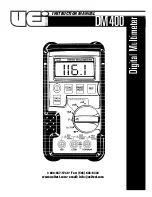
Input Limits
Function
Maximum Input
Voltage AC or DC
Resistance, Continuity
600V AC RMS/600V DC
600V AC RMS/600V DC
2
General Specifications
Insulation
Class 2, Double insulation
Continuity Test
Low Battery Indication
“ ” is displayed
Display
4000 count LCD display
Over Range Indication
“OL” is displayed
Polarity
Minus symbol “-“ is displayed for negative polarity
Measurement Rate
3 readings per second, nominal
Auto Power Off
After approx. 15 minutes of inactivity
Input Impedance
10M
Ω
VDC
AC Response
True RMS
AC Bandwidth
40Hz to 1kHz
Batteries
2 AAA 1.5V batteries
Operating Environment
Storage Environment
-4°F to 140°F (-20°C to 60°C) at < 80% relative humidity
32°F to 122°F (0°C to 50°C) at < 75% relative humidity
Operating Altitude
2000 meters
Dimensions/ Weight
5.5” x 3.0” x 1.6”/ 0.50lb (138 x 75 x 41mm/227g)
Safety
Complies with UL 61010-1 v.3 for measurement
Category lV 600V, Polution Degree 2
Audible signal if the resistance is approx. 50
Ω
or less
Enclosure
Double Molded, IP67 (waterproof and dust tight with plugs or
test leads inserted into input jacks)
Introduction
1
The Southwire 16030A auto selects AC or DC voltage and provides True RMS
readings for more accurate measurements. The 16030A also checks resistance
and continuity and offers a built in non-contact voltage detector and flashlight for
added convenience. The Autohold feature automatically holds the reading on the
display when the leads are connected to the circuit being tested. This meter is
fully tested and calibrated and, with proper use, will provide many years of reliable
service.
WARNINGS
• Read, understand and follow Safety Rules and Operating Instructions in
this manual before using this meter.
• The meter’s safety features may not protect the user if not used in
accordance with the manufacturer’s instructions.
• Ensure that the test leads are fully seated in the input jacks and keep
fingers away from the metal probe tips when taking measurements.
• Before changing functions using the selector switch, always disconnect
the test leads from the circuit under test.
• Use only UL listed test leads with the proper safety category rating.
• Comply with all applicable safety codes. Use approved personal
protective equipment when working near live electrical circuits -
particularly with regard to arc-flash potential.
• Use caution on live circuits. Voltages above 30 V AC rms, 42 V AC peak,
or 60 V DC pose a shock hazard.
• Do not use if the meter or test leads appear damaged.
• Verify operation before using meter by measuring a known live voltage.
• Do not use the meter in wet or damp environments or during electrical storms.
• Do not use the meter near explosive vapors, dust or gasses.
• When replacing the battery or fuses, be sure to secure the battery
compartment door firmly to maintain the waterproof and dust proof
integrity of the meter. Loose or overtightened screws, or an improperly
seated o-ring may compromise the meter's water and dust ingress
protection.
• Do not use the meter if it operates incorrectly. Protection may be
compromised.
• Do not operate meter while Low Battery warning is on. Replace
batteries immediately.
• Do not apply voltage or current that exceeds the meter’s maximum
rated input limits.



































